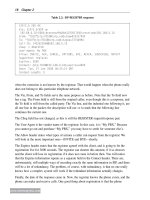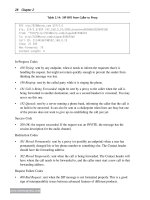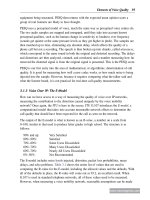Scalable voip mobility intedration and deployment- P1 pot
Bạn đang xem bản rút gọn của tài liệu. Xem và tải ngay bản đầy đủ của tài liệu tại đây (315.33 KB, 10 trang )
Q
Newnes is an imprint of Elsevier
30 Corporate Drive, Suite 400, Burlington, MA 01803, USA
Linacre House, Jordan Hill, Oxford OX2 8DP, UK
Copyright © 2009, Elsevier Inc. All rights reserved.
No part of this publication may be reproduced, stored in a retrieval system, or transmitted in any
form or by any means, electronic, mechanical, photocopying, recording, or otherwise, without the
prior written permission of the publisher.
Permissions may be sought directly from Elsevier’s Science & Technology Rights Department in
Oxford, UK: phone: (+44) 1865 843830, fax: (+44) 1865 853333, E-mail: permissions@elsevier.
com. You may also complete your request online via the Elsevier homepage (),
by selecting “Support & Contact” then “Copyright and Permission” and then “Obtaining
Permissions.”
Library of Congress Cataloging-in-Publication Data
Application Submitted
British Library Cataloguing-in-Publication Data
A catalogue record for this book is available from the British Library.
ISBN: 978-1-85617-508-1
For information on all Newnes publications visit our Web site at www.elsevierdirect.com
09 10 11 12 13 10 9 8 7 6 5 4 3 2 1
Printed in The United States of America
Working together to grow
libraries in developing countries
www.elsevier.com | www.bookaid.org | www.sabre.org
Q
To my little e.b., Noah Vinh, and his mother, my loving wife Regina
1
CHAPTER 1
Introduction to Voice Mobility
1.1 Why Voice Mobility?
The term voice mobility can mean a number of different things to different people. Two
words that can be quite trendy by themselves, but stuck together as if forgotten at a bus
station long past the last ride of the night, the phrase rings a number of different, and at
times discordant, bells. Mobility is something that can be quite useful, but it is not always
easy to justify spending large sums of money just for a network that can provide this
feature. The lack of interest in mobile IP is just one example. Desktops don’t seem to need
mobility, and laptops can use whatever IP address they get. And although voice—especially
voice over IP—has become the cornerstone for a number of large enterprise voice networks,
as the days of analog or telephone-specific digital phone lines has past, it is not used for
every application, at every time. Sometimes typing is just more efficient than talking. There
seems to be a bit of Web 2.0 in the concept, perhaps the setting up of lofty expectations that
are impossible to reach, based on recurring themes that were once passé but have now
returned in a slightly different, more confusing form.
However, one thing is for certain: voice mobility does have the ability to blend together
the most obvious applications of voice and place the result directly into the hands of the
enterprise. The driving force behind voice mobility is that voice immobility never quite
made sense, with wires and heavy, strapped-in handsets that were necessary only because
voice had not been easily sent without the copper cabling. The cellphone proved this true
in a massive way, and landline phones are quickly withering on the vine, being replaced by
these multipurpose, flashy, and quite useful devices that seem to do so much more now than
a telephone ever did. This way of thinking, seeded into every person’s mind—that voice
belongs in your pocket and not on your desk or in some small closet—demands that the
enterprise must provide voice mobility as the primary, if not the only, means for
communicating with the spoken word.
©2010 Elsevier Inc. All rights reserved.
doi:10.1016/B978-1-85617-508-1.00001-3.
2 Chapter 1
www.newnespress.com
Everyone has a cellphone, and so many want to expense it to the company, spending many
hours a week doing nothing but work on the devices. This can be costly for organizations
that need to avoid wasteful spending, and oftentimes the mobility need not extend quite
as far as the other side of the world—perhaps the other side of the building will do. Or
perhaps not, and the mobile workforce does really need to access their corporate voicemail,
and email, and maybe even paper mail, at 3:00 a.m., and the people who need this access
are not going to tolerate any plan that requires them to learn fancy software or new VPNs
or magic remote solutions. That phone in their pocket, the one with a dozen or so buttons,
or maybe a little keypad, might be the only thing they will use.
What finally made voice mobility a subject that could save real dollars was the maturation of
the unlicensed enterprise mobile network, based on Wi-Fi. Now, every enterprise has or may
shortly have a complete radio network within the office, providing access to everything that
was once wired. The enormity of Wi-Fi helped in another way, causing phone manufacturers
to place a Wi-Fi radio in their more modern, enterprise-oriented devices, so that people can
use the one device at home or at hot-spots. It did not take long before people figured out how
to combine the two functions—the voice network for the mobile operator and the data
network for the enterprise—and allow one radio or both to do all of the tasks.
This whole concept is given the label convergence, quite rightly, as it describes how
different market and technology trends have converged onto the same point, and into the
same device. Convergence cannot solve every problem, but it can and has made the phone
the most important device that many people carry. Even President Obama had to experience
the shock of being asked, at first, to let go of his voice mobility device, his trusted
BlackBerry that led him to victory over a worthy but less technologically savvy opponent.
(Thankfully, his BlackBerry was replaced with one that had more advanced security.)
This book tells the story of voice mobility in a modern setting.
1.2 Audience and Expected Background
My hope is that this book can appeal to all technology-savvy audiences. If you have an
interest in voice mobility, and are willing to explore it from a number of different angles,
then this book is written for you. Admittedly, this book is a bit thin on case studies and
examples of motivating implementations, mostly because of the difficulty in exposing the
details of the voice mobility networks for organizations who have made the jump, as they
consider their network—and the competitive advantages they gain—to be a company secret.
However, the intuition behind every concept this book explains should be readily apparent.
In fact, this intuition is the most important aspect of this book. There are times where
concepts may be explored in excruciating detail, where packet-by-packet examples are
Introduction to Voice Mobility 3
www.newnespress.com
shown and terms that make more sense to the people who built the technology behind the
network than those who built the network itself appear. However, this is done only when the
concepts within that example may be needed at a critical moment in running a real voice
mobility network. For example, the entire login and connection process for a mobile device
on a secure Wi-Fi network is shown, step by step, to give the appreciation for how many
different parts are involved, and for why the process itself makes voice quality a challenge
and network management a complicated thing. If it also lets you diagnose problems over
the air, by comparing the steps with what you are seeing, then that is even better.
At other times, the paragraphs will become chatty, staying at a high level and exposing the
reason behind why the network does what it does, and the consequences—both positive and
negative—for each decision. This approach may not immediately be useful when setting up
a voice mobility network, but it can give just the right “a-ha” moment for understanding
how voice mobility comes together.
The details on specific implementations are not provided, and vendor names are mentioned
only when necessary for recognition. This book is not a how-to guide, or a configuration or
application manual, and I highly recommend the books and papers provided by the vendors
of interest for learning the details, when those vendors have been chosen and the time for
implementation arrives. This book is a concept book, a study in the whys and wherefores of
voice mobility networking. After reading this book, you should have a good foundation to
tuck into those instruction manuals, with this book providing the concepts that the manuals
provide only slowly or among the instructions that compose the majority of the words
between their covers.
1.3 How to Read This Book (Chapter Layout)
The first four chapters make up one unit, and establish how voice flows, what
influences voice quality, and how voice is carried over IP-based networks. The next two
chapters make up a second unit, and discuss how voice runs over the unlicensed, enterprise-
owned Wi-Fi network. These chapters make up the majority of the book, as the subject of
voice over Wi-Fi is where the most complexities that an organization will see and have
the most influence in and responsibilities for occur. The remaining chapters make up the
last unit, covering cellular voice mobility, security for networking in general, and a look
to the future.
Throughout the book, the names of standards or specifications will be provided, be they
from the ITU, IETF, IEEE, or some other initialism-based organization (I’ll explain these
abbreviations within the text). Feel free to explore the details of these standards. They are
available on line, from , , and
4 Chapter 1
www.newnespress.com
respectively. (The final one has a longer URL because the IEEE is an academic and
professional society first, and happens to include standards-writing as a part of their
activities.) Digging through these references can be a chore, however, and is seldom
necessary for understanding the technology. For this reason, along with the fact that the
information contained within it is not truly verified, Wikipedia is also not always a good
source.
5
CHAPTER 2
Voice Mobility Technologies
2.0 Introduction
This chapter dives into the technology behind voice mobility. We will look into what makes
the phone work, peeling back the network and the features within it, and looking at how
voice calls are made and ended, and how voice is carried over the network.
A voice call will be described as being made of not only the bearer channel, or the part of
the voice call that actually carries the sounds, but also the signaling channel, which sets up
the call by carrying the phone number, describes whether the other end is ringing, busy, or
not found, and figures out when either side of the call hangs up. After that introduction, the
voice-specific architecture is explored, followed by the various protocols that make voice
work inside the enterprise.
2.1 The Anatomy of a Voice Call
Placing a call may seem very simple to us modern users of voice mobility. Remove the
phone from your pocket, purse, automobile cup holder, or wherever you may keep your
phone, find the name of the person you wish to call, and press the Send or Yes button to
dial the caller. However, underneath that simple experience lies a vast wealth of technology,
with electronic gears turning to produce a sound that not only sounds like a human, but is
actually recognizable as the person on the other end of the phone, even if you are driving at
65 miles an hour down the interstate.
The voice call is made of a number of moving parts. Figure 2.1 illustrates the basic
example.
Each handset contains all of the technology necessary to place a phone call. The phone
must have a microphone to capture the voice call and a speaker to play out the audio from
the other party. But beyond that, the phone must have a way of converting the analog voice
information into encoded digital signals, using audio codecs with possible compression to
ensure that high-fidelity voice quality can be carried over lower-bandwidth links. The phone
must also have one or more wireless radios, complete with technology stacks and engines
that allow the phone to connect to each of the networks, or even to hand off between the
networks. These stacks must fully understand and adequately implement the necessary
©2010 Elsevier Inc. All rights reserved.
doi:10.1016/B978-1-85617-508-1.00001-3.
6 Chapter 2
www.newnespress.com
protocols to provide high voice quality over the network, something easy for voice-oriented
technologies but much harder for data-oriented packet-switched networks. Finally, the
phones must also support a rich telephony application. This application needs to look like,
act like, and have the features of a common telephone, and yet, for voice mobility, must
now often store the addresses and phone numbers of crucial contact information, provide
access into the enterprise directories, allow for dialing as if in the office, and be manageable
PBX
Phone
Media Gateway
Public Switched Telephony Netw
ork (PSTN)
Bidirectional Voice-Carrying
Bearer Channels
Signaling Channels
Telephone Lines
Dialing Plan
Voice Codec
Extensions
Telephony
Application
Wireless Radio
Figure 2.1: The Anatomy of a Voice Call
Voice Mobility Technologies 7
www.newnespress.com
by network administrators. Many of these applications are not necessarily native to the
phone itself, but created by third-party vendors to tie multiple telephone systems together
to appear as one. The telephony applications must support all of the necessary protocols to
create a phone call, set up the audio channels, and deal with advanced features such as
voicemail and three-way calling.
The call itself is composed of two separate flows of information. The more obvious flow is
what is known as the bearer channel. The bearer channel, a term borrowed from Integrated
Services Digital Network (ISDN) technology, carries the voice of the callers. Looking back
to analog telephones, there is only one channel, an analog audio channel that provides both
the callers’ voices and the necessary tones to tell the caller what to do. Dial tones, busy
signals, and other beeps and clicks are used to communicate the number being dialed and
the state of the call. In voice mobility networks, however, the audio is kept separate from
the communication that is used to set up the call and keep it running. This is known as
out-of-band signaling. Voice can be encoded in a variety of ways, and the bearer channel is
more likely to be carried in a number of digital formats. The communication about what the
phone call is for, how it is being set up, and what state it is in is encoded in the signaling
channel. The signaling protocol is used to dial out to set up the call, provide feedback as to
whether the other phone is ringing or busy, and to finally set up the bearer channel when the
call goes through.
The signaling information needs to go somewhere, and that somewhere is to a telephone
switch. For private telephone networks, where the handsets are maintained by the enterprise
or organization who owns the network, these switches are also owned by the enterprise
and are called private branch exchanges (PBX). The term exchange and switch are
interchangeable, and these devices are the electronic equivalent of the old manual
switchboard, creating connections between two calls. The PBX (or PBXs) for analog
systems are proper switches, with internal analog phone lines that run from the handset
directly into the PBX. But for Internet Protocol (IP)-based telephone networks, the PBX is
more of the central call manager, providing for the list of extensions—users, basically, as
well as the telephone numbers each user has—and the dialing plan—the notion of how to
route calls based on the phone numbers dialed. PBXs also implement all of the advanced
features of voice mobility calling, including voicemail, call forwarding, and multiple ring.
The PBXs define the internal voice network, but calls need to be able to be routed back
onto the real, public telephone network, to allow calls in and out from the outside world.
IP PBXs rely on a module or a separate device, known as a media gateway, which has the
responsibility of converting the signaling and bearer traffic into a format and onto a wire
that is provided by the telephone company. Media gateways thus bridge the inside world to
the outside.
Let’s get a better look at each component.









